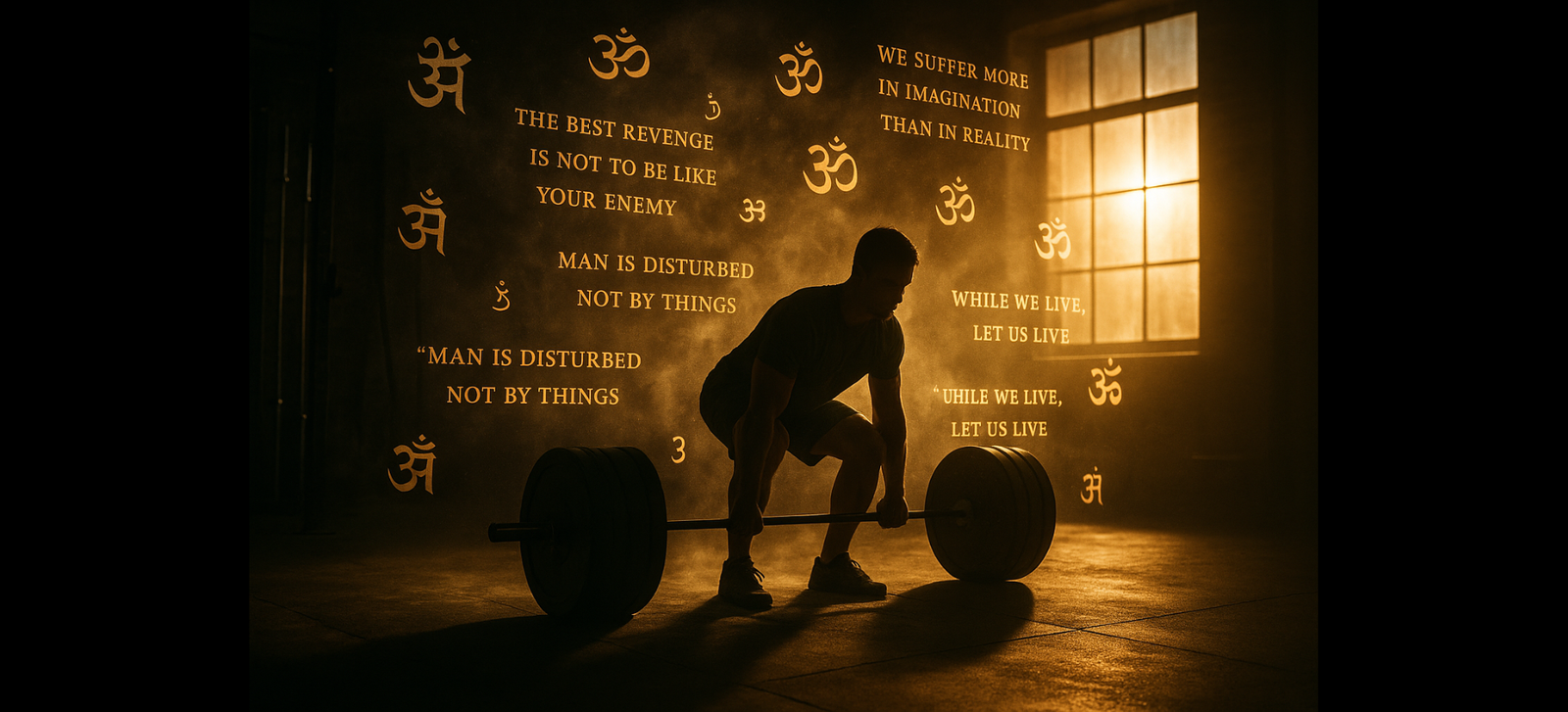What happens when deadlifts meet dharma? When your workout becomes spiritual practice? Discover how ancient wisdom transforms modern training into a path of profound personal transformation.
I Came for Biceps. I Left with Enlightenment.
Most people walk into the gym to change their body. I walked in to survive my mind.
The plan was simple: lift heavy, look good, feel strong. The reality? Every rep peeled back another layer of who I thought I was.
The gym didn’t just build my muscles. It deconstructed my entire identity.
And somewhere between the iron and the introspection, I realized: This isn’t just training. This is tapasya—the ancient practice of conscious discipline that burns away everything false until only truth remains.
Your next workout isn’t about your body. It’s about meeting the person you’re becoming under pressure.
The 405-Pound Epiphany That Broke Me Open
Wednesday morning. 6 AM. The gym was cathedral-quiet except for the hum of fluorescent lights and my own breathing.
405 pounds loaded on the bar.
This wasn’t just weight—it was every “you’re not strong enough” I’d ever heard. Every time I’d quit when things got hard. Every limiting story I’d carried about what I was capable of.
My hands were chalk-dry, rough against the knurled steel. The familiar weight of doubt settled in my chest like a stone.
“This is too much. You’re not ready. Put it down.”
But this time, instead of listening to that voice, I got curious about it.
Where does this resistance come from? What if this isn’t about the weight at all? What if this is about lifting the weight of my own limitations?
I pulled.
The bar came up clean. Lockout. Hold. Lower.
And then—I cried.
Right there on the gym floor, with chalk on my hands and the smell of rubber mats in my nostrils. Not from pain, but from recognition.
I hadn’t just lifted 405 pounds. I had lifted the story that I wasn’t strong enough to handle hard things.
That’s when I understood: The barbell doesn’t just move weight. It moves worlds.
The Science Behind the Soul: Why Iron Builds More Than Muscle
Here’s what nobody tells you in Personal Training 101:
Every time you lift, your brain literally rewires itself.
Harvard research shows that resistance training increases BDNF (brain-derived neurotrophic factor) by 300%. That’s not just muscle growth—that’s neural architecture rebuilding.
The neuroplasticity equation: Physical challenge + conscious attention = mental resilience transfer
Translation: The discipline you build deadlifting 400 pounds shows up when you’re handling a $400,000 business crisis.
Ancient yogis called this Sthira and Sukha— Steady effort combined with ease under pressure.
Modern neuroscience calls it stress inoculation training.
Same concept. Different vocabulary. Identical results: unshakeable inner strength.
The Philosophical Gym
THE STOIC SQUAT: Training Acceptance Under Pressure
“You have power over your mind—not outside events. Realize this, and you will find strength.” – Marcus Aurelius
The Practice: As you descend into the squat, mentally inventory what you can control:
- Your breathing pattern
- Your form and posture
- Your effort and intention
- Your response to discomfort
What you can’t control:
- How many reps you’ll complete
- Whether others are watching
- The outcome of this workout
- Tomorrow’s soreness
The Transfer: Three months after starting Stoic squats, my startup was hemorrhaging money. Instead of panic, I heard my squat voice: “What can I control right now? My next action, my response, my effort. Everything else is outside my power.”
We pivoted. We survived. The gym had taught me how to stay centered when the ground was shaking.
BUDDHIST BENCH PRESS: Practicing Non-Attachment to Results
“Pain is inevitable. Suffering is optional.” – Buddha
The Practice: Lying under the weight, you practice the ultimate lesson in letting go while taking right action. Push with full effort, but hold the outcome lightly.
Between sets, sit in meditation posture. Watch the sensations in your muscles without labeling them “good” or “bad.” Just observe. Just breathe.
The Transfer: My relationship was falling apart. Instead of gripping tighter or pushing harder, I remembered my bench press lessons: Full effort, light attachment. Show up completely, but don’t grasp the outcome.
We broke up peacefully. The gym had taught me how to love fully without possessing completely.
VEDANTIC CARDIO: Finding the Eternal in the Temporary
“You are not the body. You are not the mind. You are the awareness that observes both.” – Advaita Vedanta
The Practice: During long cardio sessions, separate yourself into observer and observed:
- The body that’s moving
- The mind that’s complaining
- The awareness that’s watching both
Breathe with the mantra: “I am not this discomfort. I am the space in which discomfort arises.”
The Transfer: When my father died, grief felt like it would consume me. But cardio had taught me: I am not the grief. I am the awareness experiencing grief. It will pass through me, not destroy me.
The Laboratory of Character: What Resistance Really Teaches
FAILURE IS FEEDBACK, NOT DEFEAT
In the Gym: Missing a lift isn’t failure—it’s data about your current capacity. In Life: Getting rejected, losing money, making mistakes—all information, not identity.
The Practice: When you fail a rep, pause. Get curious. What can this teach you? Adjust and try again.
PROGRESSIVE OVERLOAD = PROGRESSIVE SOUL-LOAD
In the Gym: Gradually increasing weight forces adaptation. In Life: Gradually increasing challenges forces growth.
Ancient Greek Concept: Arete—excellence through deliberate difficulty.
The Practice: Don’t just add weight to your bar. Add complexity to your life. Take on projects that scare you. Have conversations that matter. Date people who challenge you to evolve.
FORM OVER EGO = PROCESS OVER OUTCOME
In the Gym: Perfect technique with lighter weight beats sloppy ego-lifting. In Life: Consistent right action beats dramatic gestures every time.
Taoist Principle: The journey IS the destination.
The Practice: Stop measuring worth by controllable results. Measure it by the integrity of your process.
The Daily Practice: Philosophical Fitness Protocols
MORNING MOVEMENT MEDITATION (30-45 mins)
Monday – Stoic Strength:
- Heavy compound lifts
- Between sets: “What can I control in this moment?”
- Focus on effort, not outcome
Tuesday – Buddhist Bodyweight:
- Yoga or calisthenics flow
- Breathe into discomfort without resistance
- Practice presence with whatever arises
Wednesday – Warrior Intervals:
- High-intensity training
- When you want to quit, get curious: “What’s the story I’m telling myself?”
- Push through the narrative, not just the burn
Thursday – Vedantic Cardio:
- Long, steady movement
- Separate observer from observed
- Find stillness within motion
THE PHILOSOPHICAL FITNESS JOURNAL
After each workout, reflect:
- “What resistance did I meet today—physical and mental?”
- “Where did I choose courage over comfort?”
- “How can I apply this lesson outside the gym?”
- “What story about my limitations got challenged?”
WORKOUT MANTRAS THAT REWIRE YOUR BRAIN
Instead of “No pain, no gain,” try:
- “This too shall pass” (for enduring discomfort)
- “I am not my thoughts” (when the quit-voice gets loud)
- “Effort is my offering” (for releasing outcome attachment)
- “Strong body, steady mind” (for integration practice)
Beyond the Mirror: When Fitness Becomes Service
Here’s the plot twist that changes everything:
Getting strong isn’t selfish. It’s sacred service.
The world doesn’t need more people with perfect bodies and chaotic minds. It needs people who don’t break under pressure. Who can carry others when they can’t carry themselves. Who model what’s possible when discipline meets compassion.
Your transformation becomes their permission.
When you show up consistently—not just to the gym, but to life—you give others permission to do the same.
When you handle adversity with grace—because you’ve practiced it under barbells—you show them what’s possible.
Ancient Sanskrit concept: Lokasangraha—holding the world together through right action.
Your six-pack isn’t the goal. Your unshakeable presence in a shaky world? That’s the real service.
The Deeper Game: Strength as Spiritual Practice
After years of training this way, something profound happens:
You stop needing external validation to feel whole.
Because the gym taught you that your worth isn’t measured in pounds lifted or pounds lost. It’s measured in moments when you chose growth over comfort. Consistency over convenience. Courage over excuses.
You become the kind of person who:
- Doesn’t avoid difficulty—you dance with it
- Doesn’t need perfect conditions—you create strength within chaos
- Doesn’t quit when motivation dies—you’re powered by something deeper
- Doesn’t separate body and soul—you understand they’re one sacred system
This is what the ancients meant by Jivanmukti— Liberation while living. Freedom found not by escaping the body, but by fully inhabiting it with consciousness.
The Paradox: Letting Go by Gripping Tight
The deepest lesson the gym teaches isn’t about holding on—it’s about the dance between effort and surrender.
You grip the bar tight, but hold the outcome lightly. You train with discipline, but rest without guilt. You push your limits, but accept your humanity.
This is the middle path the Buddha discovered under the Bodhi tree. The same path you can discover under the barbell.
Your Invitation: Transform Training into Transcendence
Your next workout is a choice point.
You can train like everyone else—chasing numbers, avoiding discomfort, measuring worth by appearance.
Or you can train like the warrior-philosophers of old—using iron as inquiry, sweat as prayer, and every rep as a question about who you’re becoming.
The equipment is the same. The exercises are the same. But you? You’re about to become someone completely different.
Someone who understands that:
- Every workout is a philosophy class with weights
- Every rep is a conversation with your resistance
- Every drop of sweat is an offering to your highest self
The iron doesn’t judge. It just asks: “How conscious do you want to become?”
Not just in your body. In your entire existence.
The Ultimate Question: What Are You Really Training For?
Six months from now, your body will be different. But more importantly—will your character be different?
Will you be the kind of person who:
- Shows up when it’s inconvenient?
- Stays calm when others panic?
- Finds strength when everything falls apart?
- Chooses growth when comfort is easier?
That’s what you’re really training for. Not the perfect physique. The unbreakable spirit that lives within it.
Ready to Train Your Soul as Hard as Your Body?
👉🏽 Download the Philosophical Fitness Toolkit (detailed protocols + reflection prompts) 👉🏽 Join the Iron Wisdom community—where strength training meets consciousness training 👉🏽 Subscribe for weekly workouts that build both muscle and meaning
Coming Next: “Digital Detox Diaries: 72 Hours Without My Phone (And the Voices It Finally Let Me Hear)”
Because sometimes you have to disconnect from the digital to reconnect with the divine. 📵🧘♂️✨


Leave a Reply